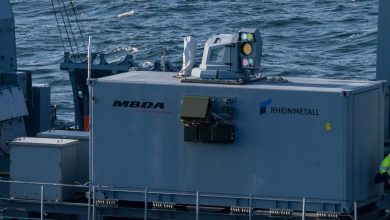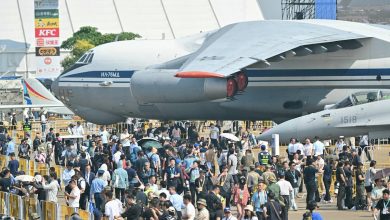GOP funding boost targets Golden Dome, high-tech fighters and ships

Republican lawmakers are proposing major increases for top Pentagon priorities in their $150 billion budget reconciliation package — pushing funding toward efforts like Golden Dome, advanced fighter jet and drone procurement, shipbuilding and munitions production.
The House Armed Services Committee will debate the package Tuesday as part of a process called reconciliation, which allows the party with a congressional majority to fast-track legislation without risking a filibuster. House Republicans expect to pass the bill in May and then send it to the Senate for approval.
House Armed Services Committee Chairman Mike Rogers, R-Ala., called the proposed investment “historic.”
“Our defense industrial base has weakened. America’s deterrence is failing and without a generational investment in our national defense, we will lose the ability to defeat our adversaries,” Rogers said in a statement Sunday. “With this bill, we have the opportunity to get back on track and restore our national security and global leadership.”
The Trump administration’s Golden Dome advanced missile defense shield is among the biggest beneficiaries. The bill suggests adding $24.7 billion for ground and space-based missile defense. That includes $7.2 billion to develop and buy space-based sensors, $5.6 billion for space-based intercept capabilities, $2 billion for a nascent Space Force effort to use satellites to track air-moving targets and $2.4 billion for non-kinetic missile defense effects.
The Pentagon is still crafting its architecture recommendations for Golden Dome, which will include a mix of advanced sensors and potentially a fleet of in-space interceptors designed to defeat enemy missiles. Officials have said this initial analysis phase involves determining which existing capabilities to scale and what new technologies it will need to develop.
The Defense Department plans to request funding for the effort in fiscal 2026. A bill introduced in February by Sen. Dan Sullivan, R-Alaska, and Sen. Kevin Cramer, R-N.D., proposes $19.5 billion for Golden Dome in next year’s appropriations. That funding will likely be spread across new and existing programs within the Space Force and the Missile Defense Agency, which could see significant boosts to their relatively small budgets. The Space Force’s annual budget is around $30 billion and the MDA’s about $10 billion.
Aircraft and nuclear triad modernization
The bill also includes $7.2 billion to accelerate the development of new, advanced fighters and drones for the Air Force and Navy.
That air superiority funding includes $900 million to accelerate work on both the Air Force and Navy’s versions of the sixth-generation Next Generation Air Dominance fighter. The Air Force’s Boeing-made F-47 — which President Donald Trump unveiled in an Oval Office ceremony last month — would get $400 million to accelerate its production, and the Navy’s F/A-XX would get half a billion.
The collaborative combat aircraft program, the military’s effort to create autonomous drone wingmen that could fly alongside NGAD or advanced fighters like the F-35, would get $678 million. Both the Biden and Trump administrations have viewed CCAs as an important part of the U.S. military’s future airpower force, and a way to expand its reach at prices cheaper than jets flown by human fighters.
The biggest portion of the reconciliation bill’s air superiority funding would send an additional $3.2 billion to increase production of Boeing’s F-15EX Eagle II fighter. The bill also would set aside $474 million to increase the production of EA-37B Compass Call electronic warfare aircraft, which are being made by BAE Systems and L3Harris out of Gulfstream G550 business jets.
The Air Force and Navy’s efforts to modernize their respective legs of the nation’s nuclear triad would get another $13 billion. That would include $4.5 billion to accelerate the Air Force’s procurement of the Northrop Grumman B-21 Raider stealth bomber, which is planned to replace the B-1 Lancer and B-2 Spirit fleets and be the service’s main aircraft for delivering nuclear weapons.
It also includes $1.5 billion to reduce the risk of the LGM-35A Sentinel intercontinental ballistic missile, which is also to be made by Northrop and will replace the nation’s arsenal of more than 400 Minuteman III nuclear missiles. The Sentinel program’s projected future costs have grown considerably, as the effort to build the massive infrastructure needed to operate the missiles is more complicated and expensive than originally expected.
The bill would provide $168 million to speed up the production of the Survivable Airborne Operations Center program. Sierra Nevada Corp. won a $13 billion contract from the Air Force in April 2024 to build the “doomsday planes,” which would allow the president to direct forces during a nuclear war or other devastating emergency that destroys command-and-control centers on the ground.
Lawmakers also want to provide the Navy $2 billion to speed up the development, procurement and integration of the nuclear-armed sea-launched cruise missile, or SLCM-N, and $400 million to speed up the development of Trident D5LE2 submarine-launched ballistic missiles.
Shipbuilding and Taiwan aid
The bill would include almost $34 billion for U.S. shipbuilding, so far one of the Trump administration’s top priorities for the Pentagon but also a persistent issue in recent years.
Earlier in April, the president signed an executive order related to America’s maritime industrial base, requiring the defense secretary to review what authorities could accelerate America’s lagging shipbuilding industry — some 200 times smaller than that of China.
The legislation includes funding intended to increase production overall and specific Navy systems. It features $4.6 billion for a second Virginia-class submarine in the 2027 fiscal year, $5.4 billion for two more guided-missile destroyers and $3.7 billion for the amphibious assault ship program.
Submarine funding, in particular, is key as the U.S. tries to maintain pace with the timelines envisioned under AUKUS, an agreement with the U.K. to share and eventually develop nuclear-powered submarines with Australia. Even with additional funding from Congress and Australia itself, if America can’t build enough boats to share, the deal will be in jeopardy approaching key milestones in the 2030s.
Alongside these traditional systems is more than $4.6 billion in money for underwater and surface drones, which the Navy has struggled to purchase in large numbers despite rapid advances in technology.
Lawmakers also call for $11 billion to support U.S. Indo-Pacific Command. That includes $850 million in assistance to Taiwan to “protect United States interests and deter Chinese Communist Party aggression.”
Another $4 billion would fund classified military space superiority programs and $528 million for space and ground-based surveillance programs. The proposal also includes $365 million for Army exercises and campaigns in the Western Indo-Pacific and more than $1 billion for infrastructure development in the region.
Scaling munitions and low-cost drones
A further $20.4 billion included in the bill would fund a bevy of key munitions across the services — from ballistic missiles to mines to torpedoes.
Much of the funding would help surge production of weapons otherwise whipped up and down by the Pentagon’s unsteady demand, often cutting munitions to balance out budget requests to Congress.
Some $400 million would go toward accelerating hypersonic weapons development, an area the U.S. has lagged behind while competing with China and Russia.
Far more is slated for the munitions industrial base itself. There is $2.5 billion to stockpile critical minerals, $1 billion for automated munitions factories and more than $4.5 billion in grants to build out parts of the industrial base.
Together, the investments would represent a jolt into a sector that has struggled to deliver on timelines relevant to conflicts around the world, from the wars in Gaza to Ukraine. They would also help build out production of key weapons as the U.S. continues to fear it couldn’t resupply its stores of weapons in a protracted conflict with China, which has a far larger industrial base delivering munitions in much larger numbers.
Republicans also specify a need for more investment in scaling production of low-cost technologies across the Defense Department, proposing $11 billion across a number of offices and programs.
The bill would add $2 billion for the Defense Innovation Unit in fiscal 2025 — more than triple the amount of its prior-year funding. It would also add more than $1 billion each for three efforts: expanding the industrial base for small uncrewed systems, developing and buying low-cost cruise missiles and speeding up procurement and fielding of “innovative technologies.” Finally, it would funnel $500 million toward existing programs to buy attritable, autonomous systems — which likely includes the Pentagon’s Replicator initiative.
Courtney Albon is C4ISRNET’s space and emerging technology reporter. She has covered the U.S. military since 2012, with a focus on the Air Force and Space Force. She has reported on some of the Defense Department’s most significant acquisition, budget and policy challenges.
Stephen Losey is the air warfare reporter for Defense News. He previously covered leadership and personnel issues at Air Force Times, and the Pentagon, special operations and air warfare at Military.com. He has traveled to the Middle East to cover U.S. Air Force operations.
Noah Robertson is the Pentagon reporter at Defense News. He previously covered national security for the Christian Science Monitor. He holds a bachelor’s degree in English and government from the College of William & Mary in his hometown of Williamsburg, Virginia.







